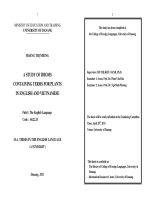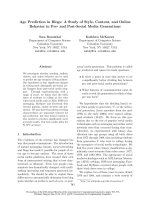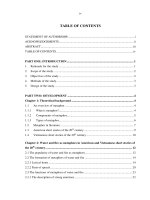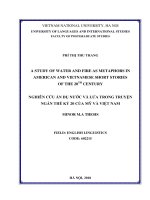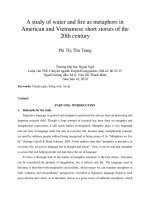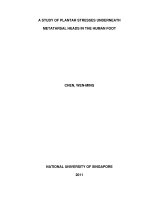A study of farmers awareness towards zero tillage in Haryana state
Bạn đang xem bản rút gọn của tài liệu. Xem và tải ngay bản đầy đủ của tài liệu tại đây (333.92 KB, 4 trang )
Int.J.Curr.Microbiol.App.Sci (2019) 8(5): 2069-2072
International Journal of Current Microbiology and Applied Sciences
ISSN: 2319-7706 Volume 8 Number 05 (2019)
Journal homepage:
Review Article
/>
A Study of Farmers Awareness towards Zero Tillage in Haryana State
Pawan Kumar1*, P.S. Shehrawat1, Pushpa2 and J.S. Malik1
1
Department of Extension Education, 2Department of Mathematics and Statistics, CCS
Haryana Agricultural University, Hisar, Haryana, India
*Corresponding author
ABSTRACT
Keywords
Awareness, Zero
Tillage,
Conservation
Practice, soil
erosion
Article Info
Accepted:
17 April 2019
Available Online:
10 May 2019
The study was conducted in two different ecological zones of Haryana to determine the
farmers’ awareness towards zero tillage to conserve the soil as the degradation is
increasing day by day. A group of 240 respondents were interviewed with help of a well designed interview schedule. The responses of farmers were obtained on three-point
continuum scale as ‘fully aware’ ‘aware’ and ‘not aware’ against each statement and
weight age were given as 3, 2 and 1, respectively. Aggregate total weight age score was
calculated for each statement and on the basis of so calculated score, total weighted score
and weighted mean score were obtained. Finally, rank orders were assigned according to
the obtained weighted mean score. Out of the total respondents 51.66 per cent respondents
belongs to small and marginal category of land holding, majority (85.41%) of respondents
had high availability of farm inputs and out of the total respondents 58.33 per cent
respondent had at least canal and 54.17 per cent respondents had at least submersible pump
as the main source of irrigation. The study elaborates that awareness about ‘Zero tillage
reduce the field preparatory cost’ and ‘Zero tillage reduce the labor and fuel costs’ were
high among the farmers. However, awareness about ‘Zero tillage helps to reduce the
infestation of weed’ and ‘Zero tillage helps in carbon Sequestrations’ were low.
Introduction
The concerns on the sustainability of
agricultural systems have increased recently
because the agricultural edges have already
expanded near to the maximum all over the
world (Cardoso et al., 2013). In many regions
of the world, there is growing concern about
the soil productivity and wider environmental
implications of conventional agricultural
practices, and especially the tilling of soils by
plough, disk or hoe. This has prompted
governments and farmers to explore
alternative production methods that maintain
soil structure and productivity. Conservation
tillage, be it minimum- or no-till, is an
obvious and increasingly popular alternative,
but so too is the use of cover crops, extensive
crop rotations, and straw mulch. These wellknown practices have recently been packaged
and promoted under the label ‘conservation
agriculture’ by the Food and Agriculture
2069
Int.J.Curr.Microbiol.App.Sci (2019) 8(5): 2069-2072
Organization of the United Nations (FAO),
the European Conservation Agriculture
Federation (ECAF).
Zero tillage is an extreme form of minimum
tillage. It is also known as-no till farming,
direct drilling etc. Zero tillage is a way of
growing crops or pasture from year to year
without disturbing the soil through tillage.
Zero tillage is an agricultural technique which
increases the amount of water that in filtrates
into the soil and increases organic matter
retention and cycling of nutrients in the soil.
In many agricultural regions it can reduce or
eliminate soil erosion. It increases the amount
and variety of life in and on the soil, including
disease-causing organisms and disease
suppression organisms. The most powerful
benefit of zero tillage is improvement in soil
biological fertility, making soils more
resilient. Farm operations are made much
more efficient, particularly improved time of
sowing and better traffic ability of farm
operations.
Tilling of soil is used to remove weeds, shape
the soil into rows for crop plants and furrows
for irrigation. This leads to unfavorable
effects, like soil compaction; loss of organic
matter; degradation of soil aggregates; death
or disruption of soil microbes and other
organisms and soil erosion where top soil is
washed or blown away. Soil tillage
conventional system based on annual
ploughing had the effect of reducing hydro
stability of structural aggregates, increasing
vulnerability to degradation by soil
compaction, erosion etc. (Cerbari, 2011). Zero
tillage avoids these effects by excluding the
use of tillage.
Continuous zero till needs to be managed very
differently in order to keep or increase yield
on the field. Adopting zero tillage and other
conservation tillage practices can enhance soil
quality in cropping systems where synthetic
agro-chemicals are relied on for crop nutrition
and weed control (Carr et al., 2013).
Evers and Agostini (2001) suggested that no
tillage (NT) systems can be potentially
beneficial and it need to receive more
attention as future for agricultural and rural
development. It is also suggested that there is
urgency to raise the awareness about scope
and understanding of no-till systems for its
better adaptation and adoption. Knowler
(2003) showed that a great number of soil
conserving practices typically produce net
financial benefits for adopters, based on a
meta-analysis of over one hundred farm-level
financial analyses. He found that over 65% of
the analyses revealed net financial benefits
from adoption.
The overall goal of conservation agriculture is
to make better use of agricultural resources
(than does conventional agriculture) through
the integrated management of available soil,
water and biological resources such that
external inputs can be minimized (FAO,
2001; Garcı´a-Torres et al., 2003). Once
aware, farmers were more likely to
participate, as long as there was a good fit
with the farm situation and the costs of
compliance were low. Compliance costs are
often an obstacle to adoption (Wilson, 2000).
Farmers’ awareness towards zero tillage
(ZT)
It is clear from data presented in Table 1 that
respondents had high awareness about ‘ZT
reduce the field preparatory cost’ and ‘reduce
the labour and fuel costs’ which were ranked
1st and 2nd position with highest weighted
mean scores (WMS) 1.93 and 1.78, followed
by ‘helps to maintain adequate soil moisture
content in soil’ was ranked 3rd position with
WMS 1.73. Awareness about ‘reduce the
irrigation requirement’ and ‘maintains soil
structure’, both were equally ranked 4th
2070
Int.J.Curr.Microbiol.App.Sci (2019) 8(5): 2069-2072
position with WMS 1.68, Followed by ‘helps
cropping frequency/timeliness’, ‘decrease soil
erosion’ and ‘helps to reduce the infestation
of weed’ ranked 5th, 6th and 7th position with
WMS 1.63, 1.60 and 1.55, respectively.
While, Awareness level was low about ‘zero
tillage helps in sequestrations of soil carbon’
ranked 8th position with WMS 1.23.
Table.1 Farmers’ awareness towards zero tillage (ZT)
S. No.
Statements
1
Zero tillage reduce the field
preparatory cost
Zero tillage reduce the
irrigation requirement
Zero tillage reduce the labor
and fuel costs
Zero tillage helps to maintain
adequate soil moisture content
in soil
Zero tillage maintains soil
structure
Zero tillage helps cropping
frequency/timeliness
Zero tillage helps to reduce the
infestation of weed
Zero tillage decrease soil
erosion
Zero tillage helps in carbon
sequestrations
2
3
4
5
6
7
8
9
Fully
Aware
Not
Total
Weighted Rank
aware
(%)
aware
Weighted
Mean
Order
(%)
(%)
Score
Score
66
60
144
462
1.93
I
(27.50%)
(25%)
(60%)
44
76
120
404
1.68
IV
(18.33%) (31.67%)
(50%)
66
56
118
428
1.78
II
(27.50%) (23.33%) (49.17%)
50
76
114
416
1.73
III
(20.83%) (31.67%) (47.50%)
38
(15.83%)
35
(14.58%)
30
(12.50%)
30
(12.50%)
10
(4.17%)
86
(35.83%)
82
(34.17%)
72
(30%)
85
(35.42%)
35
(14.58%)
116
(48.33%)
123
(51.25%)
138
(57.50%)
125
(52.08%)
195
(81.25%)
Fig.1 Farmers’ awareness towards zero tillage (ZT)
2071
402
1.68
IV
392
1.63
V
372
1.55
VII
385
1.60
VI
295
1.23
VIII
Int.J.Curr.Microbiol.App.Sci (2019) 8(5): 2069-2072
A perusal of data (Fig. 1) indicated that
awareness level among respondents regarding
reduce the field preparatory cost and reduce
the labour and fuel costs was observed to be
the highest followed by Zero tillage helps to
maintain adequate soil moisture content in
soil Moreover, it was observed that awareness
level was low among farmers about the helps
in sequestrations of soil carbon. Therefore, it
is important to raise the awareness level
among farmers about the potential of zero
tillage in various contexts and more
understanding of the zero tillage systems. In
context to these findings, Evers and Agostini
(2001) reported that there is need to raise
awareness of the potential of no tillage.
References
Carr, P.M., Gramig, G. G. and Liebig, M. A.
(2013). Impacts of Organic Zero
Tillage Systems on Crops, Weeds, and
Soil Quality. Sustainability. 5: 3172320.
Cardoso, EJBN, Vasconcellos RLF, Bini B,
Miyauchi MYH, Santos CA, Alves
PRL (2003) Soil health: looking for
suitable indicators. What should be
considered to assess the effects of use
and management on soil health. 70:
274-289.
Cerbari,
V.,
(2011).
Program
de
dezvoltareşiimplementare
a
tehnologiilor
conservative
înagricultură. Agricultura Moldovei.
5: 7-9.
Evers, G., and Agostini, A. (2001). No-tillage
farming
for
sustainable
land
management: Lessons from the 2000
Brazil study tour. FAO investment
center occasional paper series No. 12:
1-26.
FAO(2001). The economics of soil
productivity in Africa. Soils Bulletin,
Rome.
Garcı´a-Torres, L., Benites, J., Martı´nezVilela, A., Holgado-Cabrera, A.
(2003). Conservation Agriculture:
Environment, Farmers Experiences,
Innovations, Socio-economy, Policy.
Kluwer Academic Publishers, Boston,
USA.
Knowler, D.J., (2003). Explaining the
financial attractiveness of soil and
water conservation – a meta-analysis
model. Paper presented at the 2003
Soil and Water Conservation Society’s
Annual
Conference,
Spokane,
Washington, July 26–30.
Wilson, G., (2000). Financial imperative or
conservation concern? EU farmers’
motivations for participation in
voluntary
agri-environmental
schemes. Environment and Planning A
32(12), 2161–2185.
How to cite this article:
Pawan Kumar, P.S. Shehrawat, Pushpa and Malik, J.S. 2019. A Study of Farmers Awareness
towards Zero Tillage in Haryana State. Int.J.Curr.Microbiol.App.Sci. 8(05): 2069-2072.
doi: />
2072

